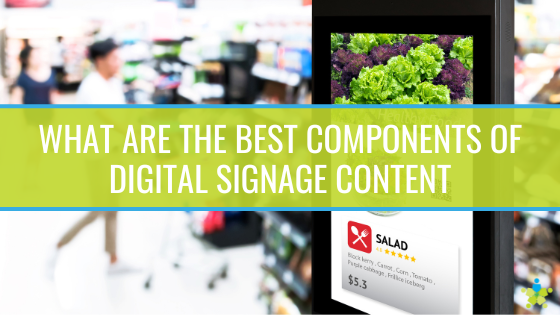[vc_row][vc_column][vc_column_text]
What Effective Digital Signage Looks Like
Digital signage is a powerful communication tool that any organization can leverage for its benefit. However, optimizing signage technology can be a challenge because it takes more than an eye-catching layout to be truly effective. Visuals are important, but there’s more to think about when determining the best components of digital signage content, including:- What messages and information your signage is sending
- When your signage is sending those messages
- Whether those messages support your organization’s goals
How To Get The Best Results From Your Digital Signage Content
There’s no competing with strong digital signage, and marketing professionals agree. According to a 2017 Samsung UK study, 84 percent of UK retailers believe that digital signage creates “significant brand awareness.” The other 16 percent may have just needed better signage that follows these principles:- Deliver messages that your visitors want to see - If you’re running a restaurant, your digital signage should make people hungry. If you’re running a clothing boutique, your digital signage should convey luxury and beauty. If you’re running a truck dealership, your digital signage should emphasize power. You get the idea. When someone walks into your shop, bank, hotel or school, they’re looking for something. If your digital signage immediately confirms that the thing they want is here, then they’re more likely to stay. This could be as simple as running a well-shot video or cycling through images of new arrivals. Give your products the platform they need to sell themselves with signage that shows them off.
- Make sure your communication is timely and responsive - If your business is affected by the calendar or by the weather, then program layouts that respond to changing conditions. When hot weather is on the horizon, a department store could switch its signage to outdoor-focused products. When it starts raining, a restaurant could use its signage to advertise delivery services. This approach gets results, as industry studies find a 5 to 10 percent increase in sales among companies that use responsive layouts.
- Keep it simple and get to the point - Although people look at digital signage longer than static layouts, you still only have a few seconds to get your message across. There’s only so much information you can deliver in that time frame, so communicate what you need to and get rid of everything else. Remove any extra layout zones that aren’t enforcing the main message and minimize your visual elements so people look at what they should look at. Consider whether advanced visual effects like animation are the right choice for your layouts, too. Motion is a big attention grabber but adds to message complexity if not handled properly.
- Several layouts are better than one - Standard industry wisdom suggests that a single layout should be on screen long enough for someone to read it three to five times. Any shorter, and people will be overwhelmed by the amount of visual information. Any longer, and people will direct their attention elsewhere. Stick to this formula and cycle through several layouts that build on or complement each other. A steady stream of brand-reinforcing information will keep your visitors engaged and focused on your messaging.
- Consider third party applications for additional functionality - There’s a ton of third-party apps that can enhance what your digital signage does. Social media feeds, sports, news, weather, trivia - if your signage is meant to entertain and occupy as well as inform, there are plenty of apps for that.
Choosing The Right Digital Signage Components
A digital signage system consists of the following components:- One or more digital displays
- A digital media player
- Digital signage software
- The content itself
- The display – So many displays can be used with digital signage that no matter what your digital signage needs to do, there is likely a hardware solution perfect for the job. Individual commercial displays can work in hallways and behind reception desks and are engineered for continuous operation. But digital signage displays can be scaled up to an incredible degree. Imagine the impact a curved, contouring display the size of an entire room could have on your messaging. Video walls that can be built to a shape or size are available, and still rare enough that they are impossible not to notice.
- The media player - Digital signage media players store and deliver content when it is requested, so it’s the brains of the operation. As such, the quality of your media players will dictate the quality of your signage. If your signage solution scales up enough, multiple media players are a must. Until then, though, choose a media player that offers high quality playback and support for most content formats. This will prevent any technical hiccups from interfering with your signage. Strong security is also critical and should be considered at the physical, OS and application level.
- The signage software - Leading digital signage software allows users to create layouts, program them and store them for future use. In this way, digital signage software is a design program and CMS rolled into one. This makes it a crucial part of the solution, so pick one that offers what your organization needs. Is it important to have hundreds of templates to design from? Do you need to manage one display or one thousand? Is real-time monitoring and updating a must? There’s no shortage of software solutions out there for digital signage, which is why many organizations turn to an AV expert for guidance when it’s time to select one.



